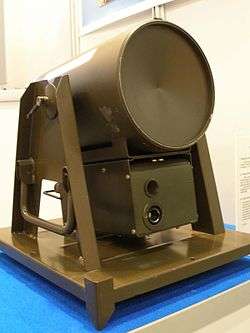Misznay–Schardin effect
The Misznay–Schardin effect (alternative spelling Misnay-Schardin), or platter effect, is a characteristic of the detonation of a broad sheet of explosive. The explosive blast expands directly away from, perpendicular to, the surface of an explosive. Unlike the blast from a rounded explosive charge, which expands in all directions, the blast produced by an explosive sheet expands primarily perpendicular to its plane, in both directions. However, if one side is backed by a heavy or fixed mass, most of the blast (that is, most of the rapidly expanding gas and its kinetic energy) will be sent in the direction away from the mass.[1] [2]
This effect was studied and experimented with by explosive experts József Misznay (alternative spelling Misnay), a Hungarian, and Hubert Schardin, a German, who initially sought to develop a more effective anti-tank (AT) mine for Nazi Germany. Some sources claim World War II ended before their design became usable, but they and others continued their work.[3] Actually, Misznay designed two weapons. The 43 M was an AT mine, the LŐTAK was a side-attack mine. The Hungarian army used these weapons in 1944-1945.[4]
The AT2 mine relies on this effect.[5]
See also
References
- ↑ Practical Bomb Scene Investigation, James T. Thurman, CRC, 2006, p.23)
- ↑ Misznay Schardin effect
- ↑ Ragnar's Action Encyclopedia, Ragnar Benson, Paladin, 1999, p.70
- ↑
- ↑ Jane's Mines And Mine Clearance 2006/2007, Colin King, Jane's Information Group, 2006, p.31
